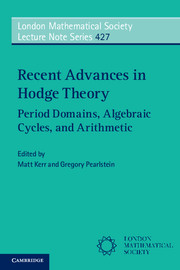Book contents
- Frontmatter
- Contents
- Preface
- Introduction
- List of Conference Participants
- Frontispiece
- PART I HODGE THEORY AT THE BOUNDARY
- (I.A) PERIOD DOMAINS AND THEIR COMPACTIFICATIONS
- 1 Classical Period Domains
- 2 The singularities of the invariant metric on the Jacobi line bundle
- 3 Symmetries of Graded Polarized Mixed Hodge Structures
- (I.B) PERIOD MAPS AND ALGEBRAIC GEOMETRY
- PART II ALGEBRAIC CYCLES AND NORMAL FUNCTIONS
- PART III THE ARITHMETIC OF PERIODS
1 - Classical Period Domains
from (I.A) PERIOD DOMAINS AND THEIR COMPACTIFICATIONS
Published online by Cambridge University Press: 05 February 2016
- Frontmatter
- Contents
- Preface
- Introduction
- List of Conference Participants
- Frontispiece
- PART I HODGE THEORY AT THE BOUNDARY
- (I.A) PERIOD DOMAINS AND THEIR COMPACTIFICATIONS
- 1 Classical Period Domains
- 2 The singularities of the invariant metric on the Jacobi line bundle
- 3 Symmetries of Graded Polarized Mixed Hodge Structures
- (I.B) PERIOD MAPS AND ALGEBRAIC GEOMETRY
- PART II ALGEBRAIC CYCLES AND NORMAL FUNCTIONS
- PART III THE ARITHMETIC OF PERIODS
Summary
We survey the role played by Hermitian symmetric domains in the study of variations of Hodge Structure. These are extended notes based on the lectures given by the first author in Vancouver at the “Advances in Hodge Theory” school (June 2013).
Introduction
There are two classical situations where the period map plays an essential role for the study of moduli spaces, namely the moduli of principally polarized abelian varieties and the moduli of polarized K3 surfaces. What is common for these two situations is the fact that the period domain is in fact a Hermitian symmetric domain. It is well known that the only cases when a period domain is Hermitian symmetric are weight 1 Hodge structures and weight 2 Hodge structures with h2,0 = 1.
In general, it is difficult to study moduli spaces via period maps. A major difficulty in this direction comes from the Griffiths’ transversality relations. Typically, the image Z of the period map in a period domain D will be a transcendental analytic subvariety of high condimension. The only cases when Z can be described algebraically are when Z is a Hermitian symmetric subdomain of D with a totally geodesic embedding (and satisfying the horizontality relation). This is closely related to the geometric aspect of the theory of Shimura varieties of Deligne. It is also the case of unconstrained period subdomains in the sense of [GGK12]. We call this case classical, in contrast to the “non-classical” case when the Griffiths’ transversality relations are non-trivial.
The purpose of this survey is to review the role of Hermitian symmetric domains in the study of variations of Hodge structure. Let us give a brief overview of the content of the paper. In Section 1, we review the basic definitions and properties of Hermitian symmetric domains (Section 1.1) and their classification (Section 1.2) following [Mil04]. The classification is done by reconstructing Hermitian symmetric domains from the associated (semisimple) Shimura data, which are also convenient for the purpose of constructing variations of Hodge structure over Hermitian symmetric domains (Section 1.3). As a digression, we also include the discussion that if the universal family of Hodge structures over a period subdomain satisfies Griffiths transversality then the subdomain must be Hermitian symmetric (i.e. unconstrained ⇒ Hermitian symmetric).
- Type
- Chapter
- Information
- Recent Advances in Hodge TheoryPeriod Domains, Algebraic Cycles, and Arithmetic, pp. 3 - 44Publisher: Cambridge University PressPrint publication year: 2016
- 3
- Cited by

